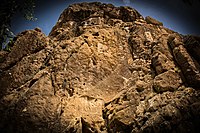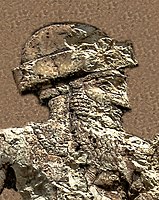Anubanini rock relief
The Anubanini petroglyph, also called Sar-e Pol-e Zohab II
Description
In this rock relief,
The general style of the Anubanini relief emulates the style of Mesopotamian royal art of the period, as well as its language, in using the Akkadian language and script for this inscription.[3]
Inscription
There's also an inscription in the
The date of the rock relief is believed to be circa 2300 BC. It was damaged about 30% during the

Behistun reliefs
This rock relief is very similar to the much later
Details of the relief
-
The Sarpul mountain, on which the relief is located (in the shadow of the edge closest to the camera). The city of Sarpul lays at the foot of the mountain.
-
The relief is located at a height of 16 meters, on the top of a cliff towering over the village of Sarpol-e Zahab. A second relief (relief of Gotarzes II, Parthian Empire) appears below.
-
Lullubi-ki ("Country of the Lullubi") on the Anubanini Rock Relief
-
Prisoners and their king (detail).[1]
-
Anubanini rock relief Akkadian language and Akkadian script inscription.[1]
-
Portrait of King Anubanini.
Early depictions
The French architect Pascal Coste painted the rock relief as early as 1840.
-
Drawing by Pascal Coste
-
Anubanini rock relief woodprint
-
Modern drawing of the relief
Other reliefs in the area
The same area of
Lullubian reliefs
Another relief named Sar-e Pol-e Zohab I is about 200 meters away, in a style similar to the Anubanini relief, but this time with a beardless ruler.
-
Outline of relief I (extracted). Beardless warrior with axe, trampling a foe. Sundisk above. A name "Zaba(zuna), son of ..." can be read.[14]
-
Sar-e Pol-e Zahab, relief III. Beardless warrior trampling a foe, facing a goddess.[1]
-
Sar-e Pol-e Zahab, relief IV. Beardless warrior trampling a foe, facing a goddess.[1]
Parthian relief
Another relief is located below the Anubanini relief, lower on the cliff. This relief was created during the Parthian Empire in the name of Gotarzes, possibly Gotarzes I, but more probably the Parthian king Gotarzes II, who ruled from 39 to 51 CE and is known to have made other reliefs, such as the equestrian relief at Behistun.[17][18]
-
The second relief, below the Anubanini relief, a Parthian relief.
-
Drawing of the Parthian relief.
Dukkan-e Daud Late Achemenid tomb
At
See also
References
- ^ ISBN 9781438453255.
- ^ ISBN 9780521564960.
- ISBN 9780684197203.
- ^ a b Cameron, George G. (1936). History of Early Iran (PDF). The University of Chicago Press. p. 35.
- ^ Morgan (1900). Mémoires. Mission archéologique en Iran. p. 67.
- ^ "نقش برجسته آنوبانی نی؛ تصویری از تمدن هزاران ساله کرمانشاه". Isna News Agency. Retrieved 24 December 2015.
- ^ Older photograph of the relief
- ISBN 9781860646751.
- ISBN 9781438453255.
- ISBN 9781134520626.
- ISBN 9788763543729.
- ^ " He wears a feather crown such as that found in a few hammered bronzes of Luristan belonging to the early first millennium B.C." in Ancient Iran. 1965. p. 43.
- ^ Vanden Berghe, Louis. Relief Sculptures de Iran Ancien. pp. 19-21.
- ^ ISBN 9781438453255.
- ISBN 9781438453255.
- ISBN 9780802058737.
- ^ Vanden Berghe, Louis. Relief Sculptures de Iran Ancien. p. 45.
- ISBN 9789025763961.




![King Anubanini. He is equipped with an axe, a bow and an arrow. He is bare-chested, wears a short skirt, a roll-brimmed hat and sandals.[9][10][1]](http://upload.wikimedia.org/wikipedia/commons/thumb/2/27/Anubanini_relief_constituents_King_Anubanini.jpg/166px-Anubanini_relief_constituents_King_Anubanini.jpg)

![Goddess Ishtar/Inanna. She wears a long, flounced dress, a hat decorated with horns and a headed collar. She is extending a ring in her right hand and has club-like weapons in her back.[1]](http://upload.wikimedia.org/wikipedia/commons/thumb/4/4d/Anubanini_relief_constituents_Ishtar.jpg/133px-Anubanini_relief_constituents_Ishtar.jpg)
![Prisoners of Anubanini, brought by Goddess Ishtar (detail). They are naked, their hands bound, and held by a ring through the nose.[11][1]](http://upload.wikimedia.org/wikipedia/commons/thumb/3/32/Anubanini_relief_constituents_prisoners.jpg/200px-Anubanini_relief_constituents_prisoners.jpg)
![Prisoners and their king (detail).[1]](http://upload.wikimedia.org/wikipedia/commons/thumb/b/bd/Anubanini_relief_constituents_group_of_prisoners_and_king.jpg/200px-Anubanini_relief_constituents_group_of_prisoners_and_king.jpg)
![Depiction of a crown-wearing king, naked, imprisoned by Anubanini. This is possibly a feathered crown as seen on some bronzes of Luristan.[12][1]](http://upload.wikimedia.org/wikipedia/commons/thumb/7/71/Anubanini_relief_constituents_prisoner_king.jpg/147px-Anubanini_relief_constituents_prisoner_king.jpg)
![Anubanini rock relief Akkadian language and Akkadian script inscription.[1]](http://upload.wikimedia.org/wikipedia/commons/thumb/0/06/Anubanini_relief_constituents_Akkadian_inscription.jpg/200px-Anubanini_relief_constituents_Akkadian_inscription.jpg)




![Sarpol-e Zahab, relief I. Beardless warrior with axe, trampling a foe. Sundisk above. A name "Zaba(zuna), son of ..." can be read. He is usually considered as a ruler of the Lullubi,[14][15] but he could be a ruler of the Kingdom of Simurrum, son of Iddin-Sin.[16]](http://upload.wikimedia.org/wikipedia/commons/thumb/0/07/Sar-e_Pol-e_Zahab%2C_relief_IV.jpg/200px-Sar-e_Pol-e_Zahab%2C_relief_IV.jpg)
![Outline of relief I (extracted). Beardless warrior with axe, trampling a foe. Sundisk above. A name "Zaba(zuna), son of ..." can be read.[14]](http://upload.wikimedia.org/wikipedia/commons/thumb/3/38/Sar-e_Pol-e_Zahab%2C_relief_I_%28extracted%29.jpg/187px-Sar-e_Pol-e_Zahab%2C_relief_I_%28extracted%29.jpg)
![Sar-e Pol-e Zahab, relief III. Beardless warrior trampling a foe, facing a goddess.[1]](http://upload.wikimedia.org/wikipedia/commons/thumb/6/63/Sar-e_Pol-e_Zahab%2C_relief_II.jpg/200px-Sar-e_Pol-e_Zahab%2C_relief_II.jpg)
![Sar-e Pol-e Zahab, relief IV. Beardless warrior trampling a foe, facing a goddess.[1]](http://upload.wikimedia.org/wikipedia/commons/thumb/b/bd/Sar-e_Pol-e_Zahab%2C_relief_III.jpg/200px-Sar-e_Pol-e_Zahab%2C_relief_III.jpg)



